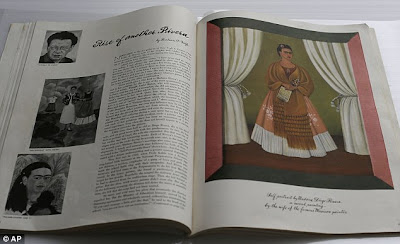FASHION EXHIBITIONS - MEXICO
https://fashionstudiomagazine.blogspot.com/2012/11/fashion-exhibitions-mexico.html
By Eva Fydrych
The regional costume she adopted was of the matriarchal community of Tehuana in southern Mexico. The style of dress worn by Frida was a highly constructed performance - a political statement of pride in indigenous Mexican culture and a camouflage for her physical ailments.
Appearances Can Be Deceiving:
The Dresses of Frida Kahlo
From 22 November 2012
MEXICO CITY - Unique Frida Kahlo's wardrobe will go on display for the first time this November. 300 pieces belonging to the Mexican painter were kept out of the public eye for more than 50 years at the request of her husband, celebrated muralist Diego Rivera. They were discovered in 2004.
The exhibition in Mexico City will showcase 22 items from Frida's colurful wardrobe, including a black velvet short cape with lace border, a worn silk blouse with square neckline, richly embroidered ethnic dresses, flowery headpieces and ornate silver jewellery. It will also explore the reasons why the artist wore them.
"We must remember that Frida � like Diego � wanted the colours, the dress, the culture of Mexican women to be public and known," - said Carlos Phillips, head of the museums that exhibit Kahlo and Rivera's work.
Another reason, according to Circe Henestrosa, who curated the exhibition, was to hide her disfigurement from a bout of polio when she was a child and a traffic accident that broke her spine in three places. Her long, full skirts hid a tiny, thin right leg, and loose blouses covered the stiff corsets she wore for back pain.
"She had a tremendous self-confidence. She was convinced that what she wore displayed who she was inside," said Alejandra Lopez, art restorer for the painter's home.
The exhibition, sponsored by Vogue Mexico, launches at the Frida Kahlo Museum on 22 November 2012.
All photos by Getty Images
All photos by Getty Images
"I don't paint dreams or nightmares. I paint my own reality" - Frida Kahlo
Las dos Fridas by Frida Kahlo
ABOUT
Frida Kahlo, a Mexican painter, was born on July 6, 1907 in Coyoac�n near Mexico City.Perhaps best known for her self-portraits, Kahlo's work is remembered for its "pain and passion", and its intense, vibrant colours.
Kahlo started painting after a serious bus accident in 1925 that changed her whole life and had a huge impact on her artistic work. Shortly thereafter, painting became her full-time career and her way to deal with her own imperfections, health problems, and emotional ups and downs. She created 143 surrealist paintings, 55 of them are self-portraits that often incorporate symbolic wounds. Kahlo's paintings were influenced by the Mexican culture and mythology and Amerindian cultural tradition. Christian and Jewish themes often appear in her work as well. When asked why she painted so many self-portraits, Frida replied:
"Because I am so often alone... because I am the subject I know best."
Photo courtesy of Zimbio
In 1953, when Frida Kahlo had her first solo exhibition in Mexico (the only one held in her native country during her lifetime), a local critic wrote:
"It is impossible to separate the life and work of this extraordinary person. Her paintings are her biography."
Her personal life was complicated. In 1929 she married the famous Mexican muralist Diego Rivera, 20 years her senior. Their relationship was passionate and survived many crises: divorce, remarriage, infidelities, Diego's affair with her sister, Frida's poor health, and her inability to have children. For most of their marriage they lived in separate houses connected together with a bridge. Frida once said:
"I suffered two grave accidents in my life� One in which a streetcar knocked me down and the other was Diego."
Kahlo died on July 13, 1954 as a result of pulmonary embolism. Some people suspected she may have died from an overdose. However, an autopsy was not performed. Her last diary entry read:
"I hope the end is joyful - and I hope never to return - Frida."
Independent and strong, Frida wrote her own rules and developed a unique personal style. She made a signature look of her thick eyebrows and ink-black hair - centre parted and slicked into a bun. Frida used big, bold accessories and strong colorful makeup. She dressed in rugged men's suits or color-soaked Mexican traditional blouses and skirts. Conventions didn't stand a chance with Frida Kahlo...
Her personal style and her love of colour was as distinctive as her paintings. She combined traditional Mexican textiles with elaborate hairstyles and eclectic jewelry to create a remarkable look. Having a huge lust for life, she was charming and alluring, and had a seductive effect on many people around her. They admired her beauty, personality, talent and dark sense of humour. The clothes she wore were a reflection of her creativity and a bold statement against life difficulties that she faced since an early age.
Different looks of Frida Kahlo (Photos courtesy of Zimbio)
The regional costume she adopted was of the matriarchal community of Tehuana in southern Mexico. The style of dress worn by Frida was a highly constructed performance - a political statement of pride in indigenous Mexican culture and a camouflage for her physical ailments.
Both her paintings and her personal style served as inspiration for many photographers and fashion designers around the world, such as Galliano, Jean Paul Gaultier, Lacroix, and just recently, Maya Hansen.
Frida Kahlo continues to amaze and influence new generations of fashion designers, stylists and photographers all over the world. Her style seems to be timeless and easy to interpret in many different ways...
Photo courtesy of Zimbio
Read more: FRIDA (A BIOGRAPHY OF FRIDA KAHLO)









